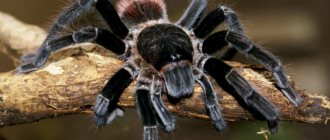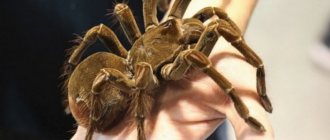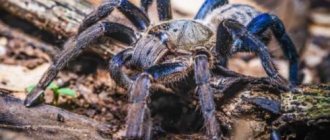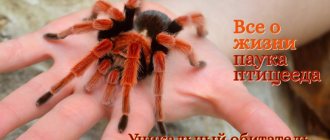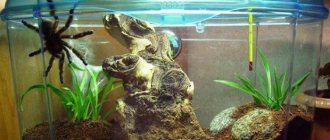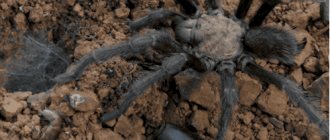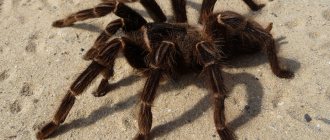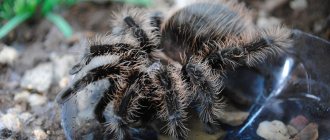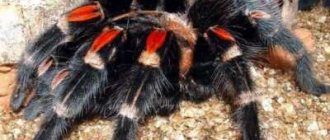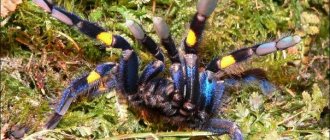Spiders 08/07/20203703 views
Grammostola rosea is perhaps one of the most popular spiders. This is due to its unusual coloring and rather calm disposition. There are two color variations of this spider. The classic color, from which the name comes, and red, completely different from the classic one.
The first is a bright pink carapace and off-white pubescence. According to the second, it is not clear why the spider is called pink. And in fact, it is brighter and stands out strongly among the colors of other spiders, and even the classic morph of this species, and therefore is more popular among breeders.
Litter substrate
Bedding lining the bottom of your spider's tank allows it to burrow and also reduces the harshness of a smooth glass or plastic floor. The substrate can be two to three inches of peat moss, soil, vermiculite or shredded coconut husks.
Try to choose a material that can be compacted. You can add a little water to achieve the perfect consistency, but choose a material that will dry quickly if water spills. Wet substrates are sure to cause anxiety in the tarantula.
What do I feed the gramostola?
Well, a few words about the diet. Since I’m not yet ready to have my own colony of marbled cockroaches, I feed my entire spider colony with whatever I have. That is, what will be caught. And since Rosochka is still young and inexperienced and may not be able to cope with bread ground beetles or millipedes, I feed her exclusively with moths and mosquitoes. He also threw small cockroaches, but, like a true woman, she is afraid of them and eats them with great reluctance. The last cockroach lived with her for a couple of weeks and, in my opinion, is still crawling around alive and well.
Temperature
Desert dwellers, this species of arachnid is very hardy and less sensitive to temperature fluctuations; Warm desert days and cold desert nights are the norm in their wild habitat. Generally, your tarantula will suit any temperature you feel comfortable with.
Additionally, Chilean rose tarantulas do not like humidity and may become agitated if they find a damp spot in their cage. Maintaining a dry environment (but not too dry) is critical to the proper management of this desert species.
Features of the appearance of the pink tarantula
This is a hairy and quite beautiful spider. Mature males have long legs, while females are stockier. Males are smaller than females.
The average body length of a tropical tarantula is 5-6 centimeters, and the paw span is 16-18 centimeters. All tarantulas have more than three phalanges on their paws.
This spider can be recognized by the pink-red tips of its legs, from which it gets its name. The color of young individuals is blue with a metallic tint, and there are black stripes on the body. And adult spiders are blue-green or purple, and the abdomen is purple-orange. The color of adult males is darker than that of females.
Food and water
Chilean rose tarantulas prefer live crickets and other large pesticide-free insects as their main food source.
Therefore, feeding them properly also means keeping the crickets near the spider and providing them with a diet that maximizes your tarantula's nutrient intake.
Adult tarantulas usually eat once or twice a week, while immature spiders may be fed more often.
Some owners suggest giving an adult spider an occasional pinky mouse, but the calcium in the mammal's bones may suppress the spider's nutritional needs. Therefore, supplementation of this food source in captivity is not recommended.
Sometimes the Chilean rose tarantula will go through a period of fasting, depending on its dietary needs. If your spider goes without food for longer than a few weeks or has a shriveled abdomen, consult with your exotics veterinarian to make sure it is not injured, dehydrated, exhausted, or stressed.
A small water bowl placed in your pet arachnid's enclosure and changed daily should keep it adequately hydrated. When updating, be careful not to spill any liquid.
Grammostola rosea RED
Grammostola rosea red (Red Chilean tarantula)
Our tarantula lives in the territories of Bolivia, Argentina and, naturally, Chile. In nature, the spider digs deep holes, in which it lives most of its life. However, its behavior in captivity is very different. In terrariums, the spider is a typical terrestrial species, which occasionally drags the substrate across the expanses of its home. A pleasant feature of this species is that the spider has difficulty moving on smooth surfaces due to poorly developed scopulae. And why does he need them if he lives underground? By the way, if you want to catch a spider from nature, you will be in big trouble, because the spider is protected under CITES Appendix 2. However, on spider farms, Grammostola is bred on a large scale. As for the size, the spider reaches 5-6 cm in body, 15-16 cm in the legs. It is quite difficult for a spider to reach sexual maturity; males can grow for 2-3 years, and females for 3-5. The fact is that the lower the temperature in the terrarium, the longer the spider will grow. The content limits are from 22 degrees to 27-28, but I don’t recommend too much heat either.
General health problems
If your spider is climbing walls, acting erratically, or spending most of its time at the top of the cage, something is wrong, and it could be as simple as too much humidity in the environment.
Maintain an ideal humidity range of 65 to 70 percent using a relative humidity meter or sensor.
All tarantulas go through periods of molting. This is often a difficult time for your spider. He may not eat and remain motionless for a long time; he may even roll over and lie on his back.
If this happens, don't be alarmed. Your tarantula is not dead; it is simply undergoing a natural but precarious growth process which, if disrupted, can be fatal.
After shedding is complete, you should avoid touching your pet for a few more weeks as his new skin has not hardened and may tear. Any damage will be permanent and potentially fatal.
Reproduction
If you decide to breed Grammostola rosea, then get ready for the fact that you will have to create seasonal fluctuations, just like in its homeland. After successful mating, the temperature should be lowered by 4 degrees, and after a while raised, which will create the illusion of wintering. After mating for about 3 months, the female prepares to weave a cocoon, then the larvae develop in it for about another 2 months. There are about 300 small spiders in the cocoon.
Author: Artem Zenkevich Editor: Tatyana Potapenko Source: [[https:/https://planetexotic.ru/]
Buying a Chilean pink tarantula
Purchasing a Chilean rose tarantula from a pet store is acceptable as long as you are confident that the new pet is being kept in excellent conditions.
However, it is wise to find a breeder as they are usually more conscientious than retail stores. Additionally, purchasing from a breeder ensures that you are not supporting an industry that is depleting this species in the wild.
Note that most pet stores only sell short-lived males because long-lived females are much more expensive.
As adults, male spiders will search for a female to mate with and, if one is not available, will die shortly after their first year. You can identify a male tarantula by its enlarged pedipalps (the second pair of legs from the front).
If you want a very long-lived pet or want to eventually breed one, start by purchasing a healthy female.
Content
When choosing a terrarium, pay attention to the fact that you need to focus on area, not height. Another advantage of rosea is that it is completely undemanding when it comes to humidity. Small spiders should be given water 2-3 times a week in small portions, but adults can simply be given a drinking bowl. To be precise, the optimal humidity should be 40-60%.
Terrarium 30*30*30 cm (25 liters) (spider)
Prices
Prices for popular varieties vary on average from 500 to 15,000 rubles. The cost of the female is much higher, since she lives longer than the male. The price also changes according to the aggressiveness scale:
- non-aggressive pet (recommended for beginner arachnophiles);
- moderately aggressive (can bite, but this is rare; suitable for breeding by arachnid lovers with experience);
- aggressive pet (recommended for keeping only experienced arachnophiles);
- very aggressive tarantula spiders (not generally suitable for home keeping).
In addition to the factors described above, the cost is affected by the categories of pets:
- harmless animals that do not cause difficulties;
- you may encounter minor difficulties in care;
- high difficulties.
When purchasing, it is important to pay attention to indicators such as the number of molts and body size. It should be noted that young individuals molt every month. Molting is usually denoted by the letter “L”.
external links
| Wikimedia Commons has media related to Grammostola rosea . |
- Grammostola rosea on care-sheet.com (Wiki Pets
) - Grammostola rosea
photo Breeding tarantulas, website of Czech Ondrej Rehak
| Taxon identifiers |
|
Danger to humans
All tarantula spiders are poisonous. If they talk about a safe animal, this means poison of low toxicity. There are no officially registered cases of human death from a bite. However, there is information that cats have died from pets. Often the bite occurs dry - without injecting poison. Then only a small hematoma remains at the site of the attack.
An allergic reaction to a toxic substance depends on the state of the immune system and age. Spider bites are potentially dangerous for children, people prone to allergic reactions, and the elderly. Possible consequences are local skin allergies, breathing difficulties, muscle spasms, vomiting, abdominal pain, weakness, dizziness.
In natural conditions, spiders shed poisonous fibers when there is a threat to their own lives, and weave them into the web when forming a cocoon with eggs or a nest. In the terrarium, the tarantula sheds its lint due to stress. Inhaling them leads to the development of allergies - rhinitis, cough, shortness of breath, difficulty breathing, lacrimation, etc.
At home, tarantulas are kept in terrariums and fed with insects. It is impossible to train or accustom spiders to anything.
Poisonous spiders
Karakurt
The black spider has a shiny body; juvenile and adult males of the species have 13 spots on their back. Males have creamy white spots, while young females have red (sometimes yellow or orange) spots. All adult females are black. Karakurts rarely come indoors, preferring grassy areas and especially hot, dry areas such as coastal dunes. They build webs close to the ground, in abandoned rodent burrows and under rocks and logs. The male karakurt stops feeding before mating and consequently dies of hunger.
Cross spiders
There are many types of crosses, they differ:
- shape;
- size;
- color.
Typically the species is 2 to 3 cm in length (females) and 1.5 to 2 cm (males). Most species are reddish brown or gray with leaf-shaped patterns on thick, triangular-shaped abdomens, and also have two prominent humps at the front. Cross spiders sometimes have a white or brown dorsal stripe with a white edge.
Hyracantidae
The upper abdomen has a dark, spear-shaped mark that runs down the middle of the abdomen from the point where the thorax and abdomen meet to about the middle of the abdomen.
The color ranges from light beige to yellow, often with a hint of green. The tips of the paws are dark brown.
These are nocturnal hunters who search for prey rather than catch it in a net. Spiders come into contact with humans if they get between the skin and sheets, clothing or shoes. They will also bite if provoked by a person while working in the garden or habitat.
Chiracantida bites are painful and the venom damages the skin, causing:
- slow healing wounds;
- itching;
- edema.
These bites are not considered medically dangerous.
Black Widow
It is a shiny, round black spider with a red hourglass mark on its ventral side (belly). There is also a red or orange spot above the spinnerets. This is the typical appearance of a female.
Male black widows are much smaller than females, with elongated purple, gray or black bodies, white ventral stripes and red, yellow or orange spots. Juvenile females are rounder than males, but have similar coloring and markings.
Body size of black widows: females from 8 to 13 mm, males from 3 to 6 mm. The paws are proportional to the body.
Brazilian wandering spider
Recluse spider
Spider sak (yellow heyracantium)
Interesting facts about the tarantula spider
The tarantula spider gained popularity due to its large size. Terrarists are attracted by the bright appearance of the pet and the peculiarities of its life. There are many interesting facts related to the life activity of these amazing animals:
- Spiders have never had and never will have a sense of attachment, so they will never be attached to their owner. You should not think that the tarantula loves the owner and will become attached to him.
- The tarantula spider will never be trained.
- It is impossible to completely exclude the aggressiveness of a spider that lives in a terrarium.
- It happens that completely balanced and calm adult spiders bite their owners.
- Males have larger body sizes than males.
- Females are more expensive because they have a longer life expectancy.
- Females often eat their mates after mating.
- Females lay eggs in a special cocoon made of spider webs. At one time, the spider is capable of laying from 50 to 2,000 eggs. After 1.5 months, nymphs hatch from the eggs.
- There should always be a lid on the terrarium to prevent the spider from escaping, especially if there are small children in the house. This precaution will help prevent an accident.
- Spiders cannot be classified as insects, since they belong to a certain class.
- Representatives of arachnids can live 2 years without eating food.
- Tarantula spiders are the largest spiders on Earth.
- Pets use a very unusual method of defense - blinding their enemy with a stream of feces.
- For patients with the phobia “fear of spiders,” experts recommend keeping tarantula spiders so that patients can overcome arachnophobia on their own. In most cases, patients are cured of obsessive phobia.
- Some spiders are excellent swimmers; they feel great in water, even diving.
The tarantula spider is a unique animal
References
- ^ a b
Muller-Esnault, Susan, DVM. "Pink Tarantulas or Chilean Pink Hair" (2008). https://www.critterology.com/rose_hair_tarantulas_or_chilean_rose_hair-192.html Archived 2015-04-19 in the Wayback Machine - *Gurley, Russ; Bro, Clarice. "Pink-haired tarantula: Chilean pink-haired tarantula." Animal world. Retrieved May 21, 2010.
- Animal world. "Pink-haired tarantula."
- Animals-Pdf. "Rosamond Gifford Zoo - Chilean Pink Tarantula" (PDF).
- ^ a b
“The tarantula shoots sharp hairs into the eye of its owner.” NBC News. January 1, 2010. Retrieved January 3, 2010. - “The synergy between the Piezo1 and Piezo2 channels confers highly robust mechanosensitivity to articular cartilage.” Retrieved November 7, 2017.
Pros and cons of home keeping
Positive aspects of keeping tarantulas in a home terrarium:
- exotic pet;
- fluffy beautiful creatures;
- do not require a lot of feed;
- the pet is interesting to watch;
- do not require much space;
- long lifespan.
In addition, spiders are good for breeding and subsequent sale of babies, since one female can produce offspring of up to 400 spiderlings (in a cocoon).
The disadvantages include:
- inability to be picked up and played with;
- maintaining a certain temperature and humidity;
- causes allergies;
- safety precautions must be observed.
A huge disadvantage is feeding spiders, since they need insects. Not in every city you can buy cockroaches and crickets, so you have to look in nearby cities, which causes some inconvenience.
Tarantula spiders do not require a lot of space
Description of spiders
Spiders have 8 legs. The body is divided into 2 parts, they are connected by a thin stalk. Most spiders have 8 eyes, some have 6. A few arachnids outside Europe have 4 or 2 eyes. Spiders' eyes do not have one location; it depends on the species. Some spiders have the same size eyes, others have different ones. Most spiders have poor vision. But some species have large front eyes with fairly good vision:
The easiest way to determine whether an arachnid is male or female is to look at the front tentacles. In females they are quite narrow; in spiders, the tips of the tentacles resemble boxing gloves. Males use them as pipettes to release sperm during mating.
Which spiders are endemic to Russia and Europe, the most common species
First molting of gramostola
Grammostola rosea is a slow-growing spider and, accordingly, rarely sheds. I don’t know how many molts Rosochka had before me, but in the second month I already began to fear for her health. However, everything went smoothly. Almost exactly 2 months after moving in with me, Rosochka faded, leaving a weightless skin of a delicate shrimp color as a keepsake.
Thinking out loud: but if people were arthropods or reptiles that tend to molt, then, for sure, this would be somehow reflected in the rules of behavior and labor legislation. For example, a shedding employee would be given a day off. And in transport they would announce “Be mutually polite, give up your seats to passengers with cubs, females with eggs and citizens in a state of molting . It is also possible that it would be prohibited to drive a vehicle in a molting state.
But that’s okay... Now, if we developed like insects with complete transformation... However, this is a topic for a separate story. However, nothing is new, for example, Pelevin has a book “The Life of Insects” .
Did you like the article? Have questions? Want to inspire the author? Leave a few comments! PS: Don't forget to visit my other website:
The entry was published in the Spiders section. Bookmark the permalink.
Area
The tarantula spider can be found in almost any country with a warm and dry climate. In Europe, this species is almost never found, with the exception of southern territories, such as Spain, Portugal, etc.
The tarantula spider prefers to settle either in trees or in burrows. Some species can build their nests on the ground. One way or another, regardless of location, the lifestyle of tarantula spiders is the same - they are all sedentary and do not make unnecessary forays out of their burrows. From the point of view of climatic conditions, the situation is ambiguous: some spiders love hot and dry places, others prefer the humid tropics.
Tarantula spider of the species Aphonopelma seemanni (lat.), front view.
Male tarantula spider of the species Aphonopelma xwalxwal (lat.).
Tartar spider of the species Grammostola aureostriata.
Female tarantula spider of the species Avicularia purpurea.
Peacock spider (Maratus volans)
The title of the most beautiful spider in the world also belongs to the jumping horse, it is called the Peacock Spider (Maratus volans)
The peacock is a small, brightly colored spider. The length of its body does not exceed 5 mm. Males are very bright, females are pale, unpresentable and very aggressive towards the opposite sex.
During the mating season, the spider selects a bride and begins to dance in front of her, raising its abdomen and spreading its third pair of legs. He tries, moves energetically and hopes for reciprocity. If he can arouse the interest of a representative of the fairer sex, he may survive. Otherwise, the female will catch and eat the annoying suitor.
